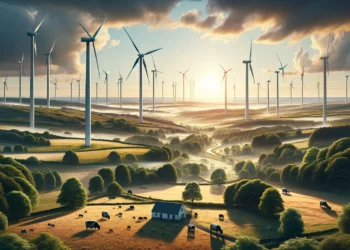In wind energy, bigger is almost always better. With this in mind, six leading universities and institutions have banded together to design that world’s largest wind turbine yet. Standing at 500 meters (1,640 feet), the SUMR project will be about 57 meters taller than the iconic Empire State Building. The concept features two 200-meter (650-foot) turbine blades which are twice the size of an American football field.

Over the last two decades or so, wind turbines have become larger and larger. In the 1980s, the largest wind turbines had a rotor diameter of only a couple tens of meters. Today, land-based supply is dominated by turbines in the 1.5 and 2 MW range — enough to power 500 American homes — and typical wind farm towers stand around 70 meters tall. This dramatic evolution in size is no accident because power output depends on the rotor blades’ size and the wind turbine tower’s height.
The higher up the turbine is, the better the winds are and the more kinetic energy can be harvested. A taller structure can thus capture more energy. It also enables lengthier blades and a larger swept area — the circular area drawn by a blade’s rotation. Interestingly, a turbine’s power output doesn’t linearly increase with the blade’s size. Because the swept area is what matters, if a system’s blade length doubles, the power output can actually quadruple.

The mega-turbine
So, all of this explains why companies and universities are going for bigger, taller wind turbines — it just makes economic sense to do so. Eric Loth, the project leader of SUMR which is directly funded by the U.S. Department of Energy’s Advanced Research Projects Agency–Energy (ARPA–E), says his team wants to design a 50-megawatt turbine, with blades that span up to 200 meters long. If they can make it work, their resulting turbine would be around ten times more powerful than anything that came before it.
The team is led by the University of Virginia and includes Sandia National Laboratories and researchers from the University of Illinois, the University of Colorado, the Colorado School of Mines and the National Renewable Energy Laboratory. Corporate advisory partners include Dominion Resources, General Electric Co., Siemens AG and Vestas Wind Systems.
The current largest wind turbines in the world are housed outside Liverpool Bay where 32 gigantic structures dot the landscape, each 195 meters (640 ft.) tall and carrying 80-meter-long (262-foot-long) blades that can generate 8 megawatts of power. SUMR50 would be more than twice as tall. Its turbine structure would be fundamentally different too as it will be fitted with two blades instead of the usual three to lower the weight of the structure. Typically, cutting down the number of blades from three to two would lower efficiency but the team is compensating for the loss with an advanced aerodynamic design.
“Exascale turbines take advantage of economies of scale,” said Todd Griffith, lead blade designer on the project and technical lead for Sandia’s Offshore Wind Energy Program.

Like today’s biggest turbines built by Dong Energy, SUMR turbines are meant for offshore deployment, as much as 80 kilometers away from the coast, where winds are generally stronger and people can’t see or hear them.
“The U.S. has great offshore wind energy potential, but offshore installations are expensive, so larger turbines are needed to capture that energy at an affordable cost,” Griffith said.
At the same time, this makes the engineering effort even more challenging. Building a half-kilometer tall wind turbine that can withstand hurricanes doesn’t sound easy at all. Loth already has some safety features in mind. For instance, wind speeds above 80 to 95 km/h will trigger the shut down of the system causing the blades to bend away from the wind instead of resisting, somewhat akin to how palm trees withstand gushing winds. According to Sandia, “SUMR’s load-alignment is bio-inspired [….] The lightweight, segmented trunk approximates a series of cylindrical shells that bend in the wind while retaining segment stiffness.”
“At dangerous wind speeds, the blades are stowed and aligned with the wind direction, reducing the risk of damage. At lower wind speeds, the blades spread out more to maximize energy production.” Griffith said.

But there are also many other puzzling engineering problems that don’t yet have a complete solution. There are many reasons no one has built a turbine with 200-meter-long blades, one of them being it’s very difficult to put them together — and offshore, tens of miles away from the coast to boot. And while bigger is generally better for wind turbines, no one is really sure where the sweet spot is. Will SUMR50 have an optimal design?These questions and more are on everyone’s mind right now in Loth’s team.
They will learn more once they have a small-scale working prototype ready by the end of this summer. It will only be two meters in diameter so next year they’ll have a much larger version with two 20-meter-long blades to run tests in Colorado. These experiments will be crucial in establishing whether a 500-meter-tall turbine is worth the investment or the concept can be shelved as sub-optimal. It’s amazing to look back and reflect how much wind turbines have changed over the last 30 years though. Just like solar energy mega structures, today’s wind turbine design echoes rapid developments in renewable energy which, in the United States, has tripled its capacity in only nine short years. Steadily but surely, the word ‘alternative’ will stop to make sense for wind or solar — they will become the de factor energy sources soon enough despite the ‘best’ efforts of some people who wouldn’t like this to happen.






